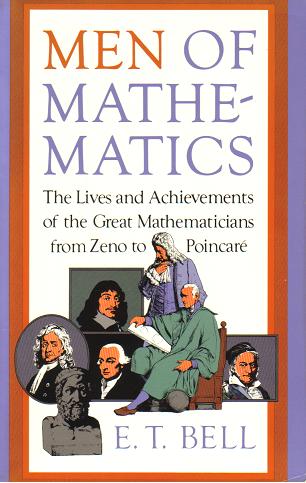Book Review: Men of Mathematics

I discovered a great book today “Men of Mathematics: The Lives and Achievements of the Great Mathematicians from Zeno to Poincare”, by E. T. Bell, a Touchstone Book, published by Simon and Schuster. The book was first published in 1937 by Scottish-born American mathematician and science fiction writer Eric Temple Bell (1883 – 1960). Besides being a gifted mathematician and a prolific writer, the author was a President of the Mathematical Society of America, Vice-President of the American Mathematical Society and of the American Association for the Advancement of Science. One can expect much from a book
written by an author with such impressive credentials. Curious students of mathematics, as well as mature teachers will find this book useful, since it suits both seasoned mathematicians and wannabes.
This is a 590 page book, and is available in paperback edition. The book contains bio-sketches of more than 27 mathematicians, arranged chronologically in 29 chapters. The book starts with Zeno of Elea (ca. 490 – 430 BC) and ends with George Cantor (1845 – 1918). Each chapter (except two chapters) is devoted
to a single mathematician. Each chapter has an aptly chosen title which gives a hint of what is to follow. Chapters are not chained to any other chapter. The book can therefore be read in any sequence.
Contrary to the impression that the book’s title may give, this book is “NOT intended to be a history of mathematics, or any section of such a history”. It is also not a chronicle of just anecdotes and episodes in the life of these men. In this spirit, the book contains a fair sprinkling of mathematical snippets related to these mathematicians. The dosage of mathematics is just enough to keep the average reader from dozing off.
As mentioned before, the book starts with Zeno of Elea (ca. 490 – 430 BC). Very little is known about Zeno’s life. Zeno of Elea is often remembered for his philosophical problems based on paradoxes. Zeno’s arguments are perhaps the first examples of a method of proof called reductio ad absurdum also known as proof by contradiction. The concept of proof, so central to all mathematics, seems to have grown from the principles set up by Zeno. It is not surprising that the book starts with a mention of Zeno.
This book gives us detailed images of the persons behind some great mathematical achievements. We can mention a few examples here. This book gives an opportunity to learn about the tug-of-war between Newton and Leibniz. It devotes an entire chapter to each of these two adversaries. Ironically, these two chapters are placed just one after the other. One can also get a glimpse of the miserable life of Abel, or the aristocratic lineage of Fermat.
Some people say that this book has a few historical inaccuracies. Complaints like this are common in narrations of such vintage and magnitude. Such blemishes, if any, can be overlooked, considering the huge amount of information compiled by the author.
The lives of many mathematicians are witness to controversies and disputes. Cantor was no exception. He sums up his reactions stoically as “The essence of mathematics resides in its freedom”. This sentence brings down the curtain on this wonderful book.
It is said that this book has inspired many young people, including the young John Forbes Nash Jr. and Freeman Dyson, to become mathematicians. It can therefore be of immense use to many of my colleagues and students.